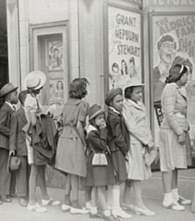
"Children in front of moving picture theater, Easter Sunday matinee, Black Belt, Chicago, Illinois" (Detail)
Credit and Original Image
Search this site:
Campus Resources
Black Film Course Offerings 2004-05
21100. African American Literature on Film (=ENGL 27100, AFAM 21100):
This course surveys a range of 20th century African American literary works that have been adapted to the screen in order to explore the formal and stylistic relationships between literature and the cinema, and our approaches to them as objects of intellectual inquiry. How are different literary forms, genres and approaches (i.e., novels, plays, autobiography, melodrama, social realism) translated into cinematic terms? What tools of literary analysis can or should we bring to the interpretation of cinematic texts—adaptations and others? How can we think about the "authorship" of an adaptation, particularly when a Black-authored text is re-presented by a white screenwriter or director or "white" production context (e.g., the Hollywood studio system)? How are films with Black literary origins presented to and received by different readers/audiences? We will pay particular attention to the ways in which race complicates issues of production, representation and address between literary and cinematic institutions. Titles we will examine include: novels and films by Oscar Micheaux; Richard Wright/Pierre Chenal/Jerrold Freedman (Native Son); Lorraine Hansberry/Daniel Petrie (A Raisin in the Sun); Chester Himes/Ossie Davis (Cotton Comes to Harlem); Alice Walker/Steven Spielberg (The Color Purple); Malcolm X & Alex Haley/Spike Lee (The Autobiography of Malcolm X); Walter Moseley/Carl Franklin (Devil in a Blue Dress); Julie Dash's film and novel Daughters of the Dust. J. Stewart Autumn.
64500. Seminar: A Separate Cinema: Race Films in Context (=ENGL 58900):
This course examines race films in their broad cultural context. From the mid-1910s to the early 1950s, African Americans produced and supported a "race film" industry, in which black-cast films were distributed to segregated African American audiences across the country. These films speak to a wide range of social, economic and political issues facing African American communities prior to the civil rights movement. They also share formal and stylistic qualities with other forms of black cultural production (literature, drama, journalism, music, and visual art). This course examines films by pioneering Black directors (Oscar Micheaux, Spencer Williams) as well as the many white-controlled race film companies, in order to trace how this industry competed—through variation and/or imitation—with mainstream Hollywood product. How did it participate in the construction of Black stars (e.g., Paul Robeson, Lena Horne, Hattie McDaniel)? How did it relate to Black urban migration, the Harlem Renaissance, and other contemporary movements? How did it attempt to respond to the politics of Black representation and modes of audience address in mainstream films produced during this period? We will think about how numerous institutional, technological and representational developments (e.g., the growth of Hollywood , the coming of sound, uses of blackface) shaped the operations of this independent industry. We will also engage with founding and recent scholarship on race films, their makers, and their audiences (Cripps, Sampson, Bowser & Spence, Green, Gaines). J. Stewart. Winter.